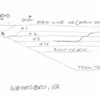Sidings will have names (not numbers).
Not true.... cajon pass sidings are numbered... click #'s so to speak.
8391 is off main 3 east bound out of San Bernardino. Hand throw switches and derails.
8392 is a controlled siding off main 3 at ono, dispatcher controlled switches and derail.
8380 and 8381 are off Main One between Baseline & Verdermont. Hand throws and derails. Now for some reason these sidings were numbered against the common rule. 8381 is next to the main...8380 is furthest from the main.... and NO ONE knows why these two tracks were numbered backwards.
My only guess is they numbered them as if they we mainlines... 8380 on the left looking east and 8381. But that makes no sense...they are not mainlines. They are sidings off Main One.
You've got an era problem here. I'd give 99:1 odds you wopuld not have seen those numbers in the 50's - 60's - pre-computer era.
Four digit siding nu8mbers indicate renumbering for a computer system in which it was decided to give a unique number to each piece of track in a large area, or even on a whole railroad.
My railroading days were in 1959 to 1980, and we rarely saw track numbers that were part of more than a single station or terminal area.
The usuual system for main line tracks was that nort and westbound was odd and south and east were even. A large majority of American railroads used that system. At stations, tracks were numbered away from the main, westbound being 1,3,5,etc. and EB being 2,4,etc. That did not apply to yards. Yard tracks were usually numbered away from the main. At a terminal with an eastbound yard and a westbound yard on opposite sides of the main, you would see a duplicate set of track numbers.
The big difference was the PRR. Their tracks were numbered in a contious sequence from one side to the other. I was at Newark, NJ last week, now Amtrak and NJT. The eastbound tracks are 1, 2 and 3 while westbound are 4, 5 and 6.
As for sidings in main line territory, look in any employee timetable of the times, and you will see only station names on sidings. If two siding overlapped, they might be called east siding and west siding. Note that station doesn't necessarily mean a place where pasengers are freigth are handled, Station is defined as a place on the main line named in the timetable.






